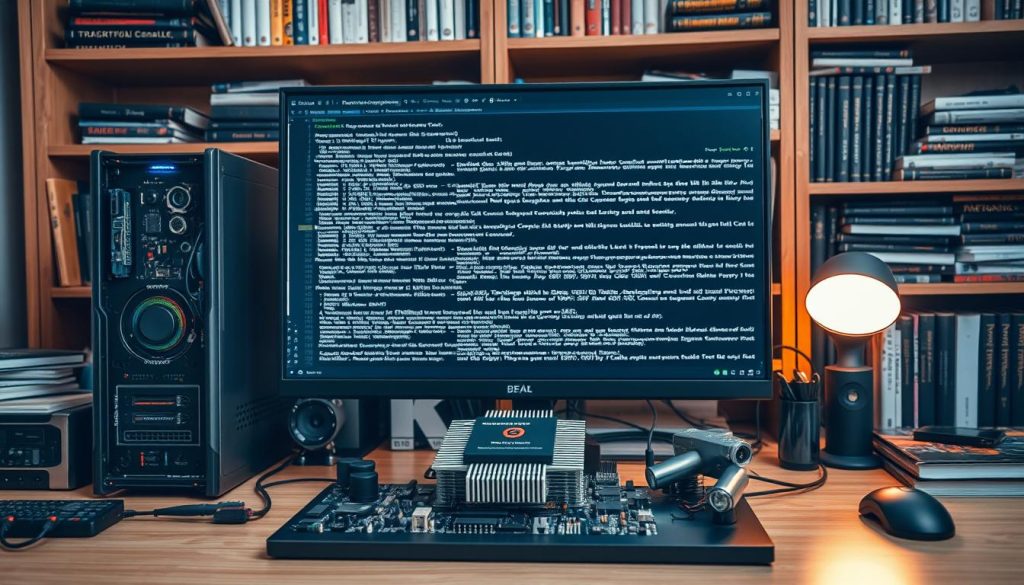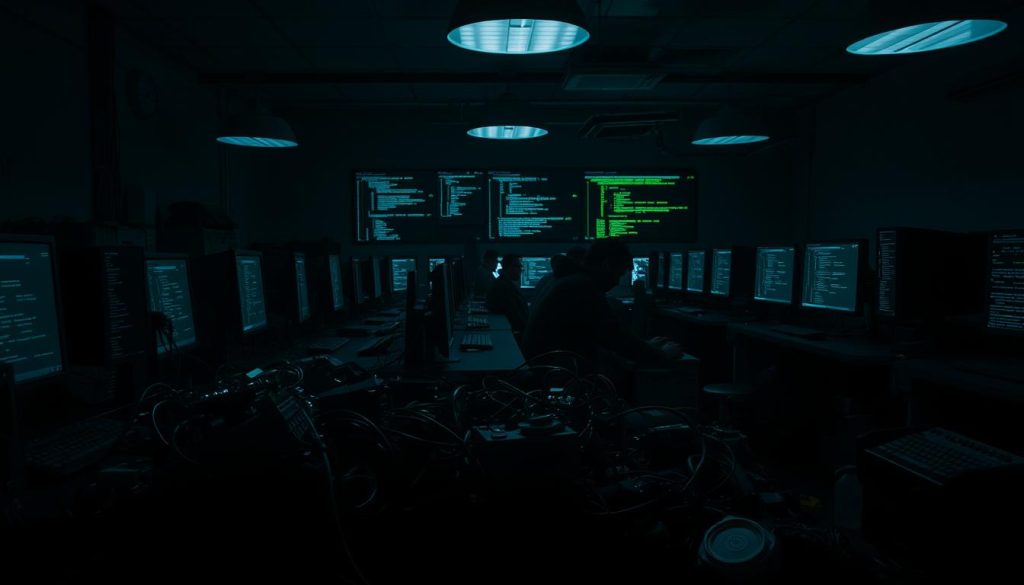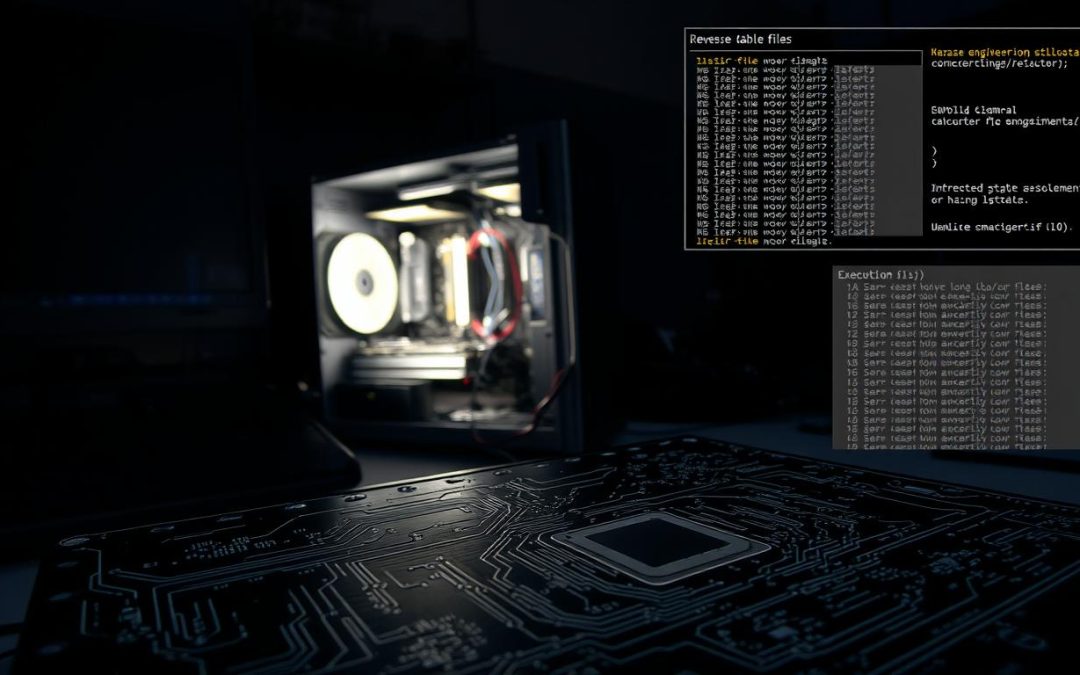Software developers and cybersecurity experts often need to extract EXE source code. This is key for understanding software, finding security issues, and seeing how systems work together.
To get EXE source code, you need special skills and a lot of technical knowledge. People like security researchers, software developers, and malware analysts use these skills. They aim to grasp software’s complex structure, spot security threats, and create detailed analysis plans.
Reverse engineering executable files is a complex task. It turns machine code into code we can read. This job needs a lot of skill, knowledge of binary code, and attention to detail.
Key Takeaways
- Reverse engineering enables deep software understanding
- Technical expertise is crucial for source code extraction
- EXE source code analysis supports cybersecurity research
- Decompilation requires specialized tools and techniques
- Professional approach ensures accurate code interpretation
Understanding Executable Files and Their Structure
Executable files are key to software, acting as detailed plans that turn code into actions. To understand them, we must grasp their complex design and how to inspect their binary code.
These files hold compiled code that computers can run. They have important parts that help software work well on various computers.
PE File Format Basics
The Portable Executable (PE) file format is the standard for Windows files. It has main parts that show how a program works:
- DOS Header
- PE Header
- Optional Header
- Data Directories
- Section Tables
Common EXE File Components
Every executable file has key parts for checking code and running smoothly:
| Component | Purpose |
|---|---|
| Code Section | Stores executable machine instructions |
| Data Section | Manages global and static variables |
| Import Table | Tracks external library dependencies |
Binary Code Architecture
Looking at binary code architecture means studying the basic structure of files. These parts show how programs use system resources and perform tasks.
“Binary code represents the fundamental language of computer execution, translating high-level programming concepts into machine-readable instructions.”
By carefully examining these parts, we can understand how they work together and what they do.
Essential Tools for EXE Source Code Extraction
To get source code from executable files, you need special tools. These tools help in breaking down complex binary code. Professional reverse engineers use advanced software to do this.

The top tools for getting source code are divided into three main types:
- Disassemblers
- Decompilers
- Debugging Platforms
Disassemblers turn machine code into assembly language. This gives us a peek into how programs work. Some key tools include:
| Tool | Primary Function | Platform Support |
|---|---|---|
| IDA Pro | Advanced Disassembly | Windows, Linux, macOS |
| Ghidra | NSA-developed Reverse Engineering | Cross-platform |
| Radare2 | Open-source Decompilation | Multiple Platforms |
Decompilers change machine code into programming languages. Advanced decompilers can make source code almost like the original. This helps in understanding software better.
Choosing the right tool depends on what you need, the platform, and the file’s complexity. It’s important to pick a tool that fits your project’s needs for accurate source code extraction.
Legal and Ethical Considerations in Reverse Engineering
Reverse engineering executable files is a complex task. It involves understanding legal and ethical rules. It’s important to know where research ends and copyright starts.
Experts in software security need to know the law well. They must be careful to avoid breaking rules. This protects both the researcher and the software creator.
Software Licensing Requirements
When you reverse engineer, you must understand software licenses. Each license has its own rules:
- Proprietary software usually doesn’t let you see the source code
- Open-source licenses might let you do some reverse engineering
- Commercial licenses often have strict rules about changing the software
“Understanding licensing terms is not just a legal requirement, but an ethical imperative in software research.” – Cybersecurity Research Institute
Intellectual Property Rights
Intellectual property is key in reverse engineering. Researchers must follow copyright laws. They should not copy or share software code without permission.
- Always get permission before decompiling commercial software
- Keep detailed records of your research
- Always respect the rights of the software creators
Compliance Guidelines
Following guidelines is important for legal reverse engineering. Here are some tips:
- Do your homework on the law before starting a project
- Keep detailed records of your research
- Use strict privacy rules
- Ask a lawyer if you’re unsure about something
By managing legal and ethical issues well, software security experts can do their job right.
Preparing Your Analysis Environment

Creating a secure and isolated workspace is key for malware analysis and vulnerability assessment. Professional reverse engineers know how important it is to have a controlled area. This area protects both the analyst and existing systems from threats.
To build a strong analysis environment, follow these steps:
- Set up a dedicated virtual machine with isolated network settings
- Install specialized reverse engineering tools and sandboxing software
- Configure network firewalls and monitoring systems
- Create snapshots for quick recovery and clean testing states
Malware analysis needs careful preparation. Researchers must follow strict security rules to avoid system contamination. They use virtualization platforms for detailed control over network interactions and system resources.
“A well-prepared analysis environment is your first line of defense in understanding potentially dangerous executable files.” – Cybersecurity Research Institute
Important things for your vulnerability assessment workspace include:
- Selecting an isolated hypervisor platform
- Configuring comprehensive logging mechanisms
- Implementing robust antivirus and behavioral monitoring tools
- Establishing secure data collection and preservation methods
By building your analysis environment carefully, you’ll have a safe space for detailed file and risk investigation.
How to Extract EXE Source Code: Step-by-Step Process
Getting source code from executable files needs a careful plan. It mixes technical know-how with the right tools. Developers and security experts often extract exe source code for many reasons. This includes software analysis, debugging, and security checks.

The decompilation process has key stages that need precision. Each step is vital for getting back the original program’s structure.
Initial File Assessment
First, do a detailed check of the executable file:
- Find out if it’s a 32-bit or 64-bit executable
- See what programming language and compiler were used
- Look for any protection or file integrity issues
- Check the file’s signatures and metadata
Decompilation Methods
There are several ways to effectively extract exe source code:
- Static Decompilation: Looks at code without running the program
- Dynamic Decompilation: Studies how the program works at runtime
- Uses reverse engineering tools for disassembly
- Uses pattern recognition and code building
Code Recovery Techniques
Advanced code recovery uses smart strategies to make source code from binary files. Experts use special software to turn machine code into higher-level programming.
By using careful decompilation methods, developers can gain deep insights into software. This helps with better troubleshooting and analysis.
Advanced Decompilation Strategies

Reverse engineering is a complex task, especially when dealing with tough executable files. Experts use advanced decompilation methods to solve these puzzles. They break down binary code that’s hard to analyze with simple tools.
At the heart of advanced decompilation is overcoming code complexity. ILSpy offers tools to tackle these challenges. It helps developers pull out useful source code from hard-to-decode files.
- Reconstruct high-level programming constructs from low-level assembly instructions
- Navigate optimized code segments with precision
- Develop robust reverse engineering workflows
Getting through disassembly needs a grasp of complex code hiding tricks. Experts use various methods:
- Pattern recognition algorithms
- Sophisticated symbolic execution
- Advanced code transformation techniques
Staying ahead in reverse engineering means always learning and improving. Experts must keep up with new ways to protect software. They need to find ways to get through more complex code layers.
Advanced decompilation is an art of transforming binary mysteries into comprehensible code narratives.
Being good at advanced decompilation lets developers see into software’s inner workings. It turns hard-to-understand files into clear, easy-to-analyze ones.
Debugging Techniques for Better Code Understanding
Debugging is key to understanding binary code. It lets experts dive deep into how programs work. They use special methods to uncover hidden parts of software.

Developers and security experts use strong debugging tools. They help see how software works. Dynamic analysis is a top way to get into the heart of executable code.
Dynamic Analysis Methods
Dynamic analysis lets researchers watch how programs run. They use:
- Breakpoint setup
- Step-by-step code running
- Tracking variables in real-time
- Watching the program’s state
Memory Inspection Tools
For deep binary code inspection, special tools are needed. They show the detailed workings of programs. These tools help experts see:
| Tool Category | Primary Function | Key Capability |
|---|---|---|
| Debugger Frameworks | Runtime Analysis | Execution Flow Control |
| Memory Mappers | Memory Segment Tracking | Dynamic Memory Allocation |
| Register Monitors | CPU State Tracking | Instruction Tracing |
Professional executable analysis needs a mix of dynamic debugging and memory tools.
Getting into software’s inner workings is more than just tech skills. It’s about figuring out the complex logic behind digital systems.
Common Challenges in Source Code Extraction

Getting source code from exe files is tough for reverse engineering pros. They face big hurdles when trying to turn binary files back into source code.
The main problems with extracting exe source code are:
- Stripped binary files with removed debugging symbols
- Complex control flow obfuscation
- Incomplete data type reconstruction
- Protection mechanisms preventing direct code analysis
Reverse engineering needs smart techniques to beat these tech hurdles. Experts must come up with clever ways to understand compiled executables.
Big challenges include:
- Symbol Elimination: Navigating binaries without original naming conventions
- Control Flow Reconstruction: Identifying original program logic
- Data Structure Recovery: Rebuilding complex memory representations
Extracting source code well needs a deep grasp of binary structures, programming languages, and decompilation methods. Skilled reverse engineers use special tools and methods to solve executable puzzles.
Mastering source code extraction requires persistent analytical skills and advanced technical knowledge.
Handling Obfuscated and Protected Executables
Malware analysis experts face big challenges with tricky executable files. These files are made to hide from being checked. They need special skills to find hidden parts and defenses.
Protecting executables has gotten much harder. Both good and bad guys use many layers to stop code analysis.
Anti-Debugging Measures
Today’s protection includes smart anti-debugging tools. They try to stop reverse engineering. These tools use different ways to defend:
- Runtime environment checks
- Process memory manipulation detection
- Timing-based evasion techniques
- Kernel-level protection mechanisms
“The cat-and-mouse game between security researchers and protection mechanisms continues to drive innovation in malware analysis techniques.”
Encryption Detection
Finding encrypted parts needs special tools and skills. Experts use advanced ways to unlock these secrets.
- Static code analysis
- Dynamic runtime decryption tracking
- Cryptographic signature identification
- Memory pattern recognition
To succeed in malware analysis, you must know how to handle these defenses. This lets security pros deal with tough executable files.
Best Practices for Binary Code Analysis

Mastering binary code inspection needs a mix of technical skills and a systematic way. Experts in code auditing must create strong methods for checking executable files well.
Important steps for good binary code analysis are:
- Having a steady documentation process
- Building detailed analysis templates
- Using strict version control
- Setting up clear reporting systems
When doing binary code inspection, it’s key to make detailed logs. This helps track changes and makes team work easier.
Good code auditing needs careful focus. Experts should:
- Write down each step clearly
- Use standard notes and tags
- Compare findings with other research
- Keep open communication
Being organized makes complex binary analysis easier and more reliable. By following these best practices, researchers can improve their binary code extraction methods.
Security Considerations During Reverse Engineering
Reverse engineering needs a careful approach to software security. Experts face complex challenges while keeping strict vulnerability assessment rules. They must be very cautious to avoid security risks.
It’s key to have strong security when analyzing unknown files. Developers and researchers need solid plans to safeguard their systems and ideas.
Malware Prevention Strategies
Good malware prevention has several steps:
- Keep analysis areas separate from main networks
- Use special virtual machines for code extraction
- Set up strict network sections
- Use top-notch antivirus and threat detection tools
Sandbox Implementation Techniques
Sandboxing is a vital method in software security. It lets researchers:
- Run potentially harmful code safely
- Watch system actions without risking main systems
- Get detailed behavior analysis
- Stop unauthorized system changes
Advanced vulnerability checks need smart sandbox setups. These setups mimic real computing settings but keep things isolated.
“Security is not a product, but a process.” – Bruce Schneier
Experts must always update their security steps. They need to stay alert for new threats in the ever-changing world of reverse engineering.
Conclusion
Extracting exe source code through reverse engineering is a complex task. It needs a mix of technical skills and ethical thinking. Experts must follow the law and use advanced decompilation methods. They also need patience, precision, and deep technical knowledge to understand executable files.
Reverse engineering is more than just getting code. It involves detailed analysis of binary structures and debugging. Success comes from using the right tools, following solid methods, and being thorough in code investigation. Developers and security researchers must keep up with new technologies and challenges.
Being a pro in reverse engineering means always learning and keeping up with new tech. It’s important to act ethically when trying to get exe source code. People should follow the law, respect others’ work, and use their skills wisely. Forums, research, and training can help build expertise in this complex area.
As tech gets better, so will reverse engineering methods. Those who keep learning and understand software well will do great in this field. Always be curious, keep learning, and act with integrity to succeed in source code analysis and extraction.

